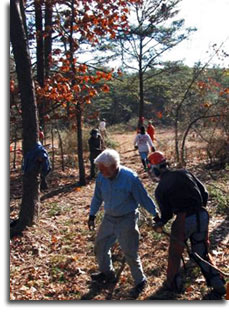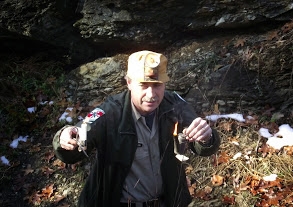Volunteer Opportunities
Message from Park Manager
Soldiers Delight is one of the more unique areas in the Maryland Park Service. So it would stand to reason that it has some very unique volunteer opportunities. If you like traditional park volunteer activities, such as working in a nature center, leading hikes, or giving interpretive programs, you will find those at Soldiers Delight.
If you like clearing brush, removing invasive plants, helping with controlled burns, then you can find those opportunities at Soldiers Delight also. Soldiers Delight has an ecosystem restoration plan and volunteers play a huge part in moving that plan forward. Take a look at the opportunities for SERP volunteers on this page.
We operate a full service nature center and museum that has opportunities for volunteer naturalists, docents, and those interested in facility maintenance and graphic design. Our wall murals in the nature center were all painted by volunteers. Many of our interactive displays were created by volunteers. We even had volunteers making fake dynamite props for this year’s Mining Park Quest. If you love animals Soldiers Delight is the home of Scales and Tales in the Central Region of Maryland. Volunteers help with animal care and interpretive programming.
If one of our quirky opportunities is right up your alley I hope you will join our Soldiers Delight Volunteer Team! We would love to have you as part of our volunteer family!
Volunteering is even easier now at Soldiers Delight NEA - our new on-line registration system is only a click away. To search for volunteer opportunities at this state park and all of the state parks in Maryland, please click here to link to the
Volunteer with Maryland State Parks webpage and then click on Opportunity Search in the Volunteer Menu on the left side of the page.
Message from the Friends of Soldiers Delight Natural Environment Area
Soldiers Delight Conservation, Inc. (the Friends of Soldiers Delight) is a non-profit group which assists the staff of Soldiers Delight with programs, serpentine restoration projects, exhibits and visitors' center assistance.We are always looking for new members to join us in supporting this vital natural resource. For more information, please contact
[email protected].
Featured Volunteer Opportunities
Volunteer Opportunities
A truly unique environment located just outside of Baltimore, Soldiers Delight has a volunteer opportunity for you! To search for volunteer opportunities at this state park and all of the state parks in Maryland, please click here to link to the
Volunteer with Maryland State Parks webpage and then click on Opportunity Search in the Volunteer Menu on the left side of the page.
Here are just a few of the things you can do:
- Adopt-A-Trail
- Scales and Tales Aviary & Programs
- Photography
- Volunteer Naturalist
 Serpentine Ecosystem Restoration Project (SERP) Volunteer Opportunities
Serpentine Ecosystem Restoration Project (SERP) Volunteer Opportunities
The Maryland Natural Heritage Program, your State non-game and endangered species program, has been working with volunteers at Soldiers Delight NEA since 1995. Our volunteers assist with ecosystem restoration by removing non-native Virginia pine and other invasive plants, allowing the native grasses to re-colonize the area. We use a variety of methods, including chipping and brush pile burns, to reduce the biomass and remove the organic material from the mineral-based soil of the serpentine outcrop.
Our efforts at Soldiers attempt to mimic what would be normal environmental conditions, if people weren’t here. We remove the non-native woody species and other invasive plant species by hand and twice a year, depending on the weather, we conduct prescribed burns. A prescribed burn is a fire which is set deliberately, in an area which has been prepared so that the fire burns only what we want it to burn, and so that surrounding areas are safe. Preparation includes constructing fire breaks to keep the fire from burning beyond the designated area, and removing or organizing especially hazardous fuel, plants or other materials which burn faster or hotter than can be managed by a fire crew. A fire crew is always on hand to make sure the fire doesn’t burn anything we don’t want it to burn. Our volunteer force is vital for both woody species removal and prescribed burns.
The majority of our work occurs during the late autumn, winter, and early spring. During the summer, we do very little work there, both for the protection of the rare plant and animal species who are going about their reproduction, and for the volunteers. The work areas on the outcrop of serpentine rock have little shade; temperatures regularly exceed 100 degrees in the summer. Additionally, the ticks are voracious. The work we perform is very physical labor. Here is a list and usual timetable for our serpentine activities:
-
October: Prepare fire breaks. Fire breaks are buffer zones, approximately 10 feet wide which surround a burn unit; we clear these buffers, using weed whackers and rakes, of any flammable material to prevent fire spread.
-
November: Autumn prescribed burn; open only to those volunteers who have completed the federal forest fire training and passed the physical test. Our burn units may be as small as a few acres to as large as 30 acres. It depends upon the landscape and how many trained wildfire fighters we have to maintain the fire break. Each prescribed burn is different. Scheduling prescribed burns is dependent upon availability of personnel and the weather so we never know until the day before an event if it will proceed. Wildfire training is overseen by the Maryland Forestry Service.
Click here to learn more.
-
December - March: cut and drag non-native pines and cedars to the chippers. We manually remove them, using sawing and girdling techniques, then increase the decomposition rate by chipping. We’ve found that using human power does the least amount of damage to the shallow serpentine soil. We will also use brush pile burning to remove woody debris. To maintain previously cleared areas, we cut non-native tree seedlings to prevent re-encroachment. Prepare fire breaks for the spring burn.
-
March - April: Spring prescribed burn. The spring burn helps the native plants by knocking back non-native plants, which tend to germinate earlier and gain a competitive edge.
Interested volunteers will be put on an emailing list and will receive the Winter Restoration calendar and schedule updates. The minimum age to volunteer is 12 years old when accompanied by a parent or adult guardian. The location of work sites may change but volunteers always meet at the Visitors Center on Deer Park Road for a briefing before moving to the work site.
Training will be provided for each task. Only DNR-certified sawyers will operate saws.
Work days, usually Saturdays, begin at 8:45 am and end at 2:30 pm. To participate, volunteers should wear sturdy footwear and bring work gloves. Layered clothing is recommended, including a hat. Volunteers also need to bring lunch and a drink and any emergency medications as the specific circumstances dictate. Volunteer work events will not proceed if the weather is inclement on the day or if previous weather has made the work site inaccessible or dangerous.
If you are interested is helping us restore and conserve this unusual ecosystem, please contact the MD Natural Heritage Program's Volunteer Coordinator, Paula Becker at 410-260-8568 or
[email protected].
Featured Volunteer – Johnny Johnson
How long have you been a volunteer?
I have been a volunteer for 20+ years.
What do you for employment?
I work in environmental permitting and compliance in the crushed stone industry.
How long have you lived in the area?
I grew up in Reisterstown, and have lived in Finksburg my entire life except for the four years I attended Virginia Tech where I received my Mining Engineering degree.
Do you volunteer other places besides Patapsco Valley?
I volunteer with the Mining History Association, other places where I can do mining programs and lead mining hikes; Lead Liberty Church Boys Battalion.
What is your favorite thing about Patapsco Valley?
The history of the park and its landscape.
What volunteer projects are you involved in at Soldiers Delight/Patapsco?
Mining History, general history, and geology of Soldiers Delight.
Describe one of your favorite volunteer memories with Patapsco.
There are so many: early days of doing mining history research for Soldiers Delight; trips to Vermont to find out more about the Tysons’ involvement in local mining; first time we tried the buddle in Red Run after spring rains. A favorite is the time I almost caught my hair on fire at the Choate Mine demonstrating my carbide lamp. I lead a night hike to the Choate Mine one time and as I was doing my lighting demonstration an owl was hooting nearby. Doing joint hikes with reknowned naturalist Jean Worthley.
Why is it important to you to volunteer?
I live to give back to the community; share my enthusiasm for local history with others; get kids interested in hands-on history instead of virtual computer.
Contact:
Volunteer Coordinator
Soldiers Delight NEA
c/o Patapsco Valley State Park
8020 Baltimore National Pike
Ellicott City, MD 21043
410-461-5005
E-mail: [email protected]